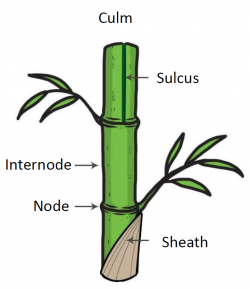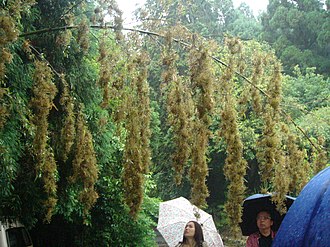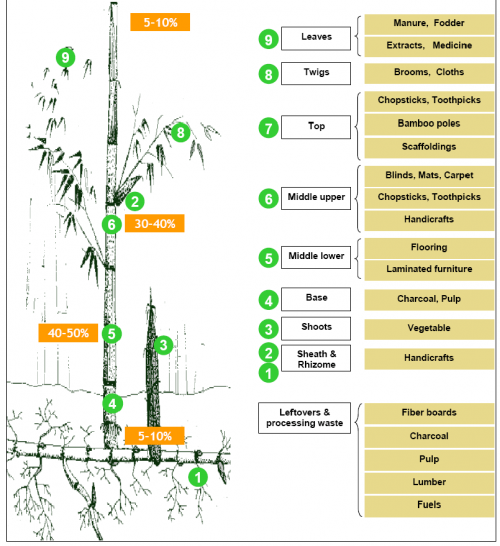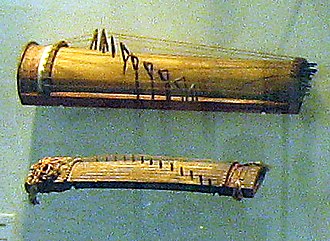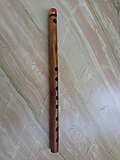Niveau d'aptitude
1
An
2010
Version
22.12.2025
Autorité approbatrice
Union de l'Asie du Sud-Est
1
Le bambou appartient à la famille des graminées Gramineae (également appelées Poaceae), sous-famille Bambusoideae. Il existe environ 60 à 70 genres et plus de 1200 espèces dans le monde du bambou. Le bambou est une herbe géante à croissance rapide avec des tiges ligneuses. C'est une plante à feuilles persistantes qui pousse toute l'année.
Selon le Guinness Book of World's Records, le bambou est la plante à la croissance la plus rapide sur terre. Bien qu'il n'identifie pas d'espèce particulière, il rapporte un taux de croissance de 35 pouces par jour. D'autres sources affirment que le bambou peut pousser de plus d'un mètre en un jour.
2
3
Le bambou pousse dans les climats tropicaux et tempérés d'Asie, sur les îles des océans Indien et Pacifique, ainsi qu'en Afrique et en Amérique du Sud. Il a besoin d'un sol fertile qui retient l'humidité et ne se gorge pas d'eau. Elle pousse bien dans la plupart des sols, sauf dans les sols alcalins, les déserts secs et les marais. Seules quelques espèces peuvent pousser par temps assez froid, c'est-à-dire en dessous de 20 degrés Celsius.
The adaptability of the bamboo is admirable as you can find them growing in plains, hilly regions, and even high altitude mountainous areas.
4
The giant bamboo species can reach a height of 20 to 40 meters (130 feet). The culms of some bamboo species grow as quickly as 1 foot or 0.3 meters per day. Some are capable of growing 2 feet (24 inches or 60 cm) or more per day.
5
Most bamboos rarely flower and they produce seeds only after 12 120 years of growth and only once in their lifetime. In fact, many bamboos only flower at intervals as long as 65 or 120 years.
6
Bamboo stands for elasticity, resilience, endurance and tenacity (strength). The bamboo stem bends in the breeze but does not break. The leaves are moved by the wind but do not fall. The plant always survives and conquers even a storm.
The plant reminds us of the need to compromise when it is necessary, to yield for the moment but eventually to go forward unbroken from all opposition.
In the Chinese culture, the bamboo is a symbol of modest virtue because of its humble droopy leaves and empty culm (stem).
7
Almost every part of the bamboo can be used either as food, fodder, medicine, paper, fuel, lumber or to be made into useful objects. Seeds are eaten as grain and the young shoots of the some bamboos are eaten, especially in East Asian cuisines. The raw leaves are a fodder for livestock.
The pulped fibres are used to make fine quality paper.
Bamboo can be made into charcoal. Bamboo charcoal comes from pieces of bamboo plants, harvested after at least five years, and burned in ovens at temperatures ranging from 800 to 1200 °C.
The hollow quality of the bamboo is ideal for making wind instruments like the flute and Sompoton, as well as percussion instruments like the Angklung.
Bamboo rods are often used to fishing poles.
8
Because bamboo is tough and durable, it needs to be handled properly with the right tools like axes, saws , coping saws and splitters. Sandpaper is needed to polish off the sharp edges of cut bamboo so as to prevent injury. Glue will be necessary to join different parts of the bamboo together. A drill will be needed to make any items that have holes in it especially when making a flute.
9
When bamboo is split open, it can be very sharp at the edges and they cut easily. Bamboo dust can cause irritation to the eyes. Upon skin contact, it may also cause allergic contact dermatitis in sensitized individuals.
Upon inhalation, bamboo dust may also cause nasal obstruction and dryness as well as irritation leading to coughing, sneezing, wheezing and sinusitis. It may also aggravate pre-existing respiratory conditions or allergies.
10
- Un objet décoratif. Exemple: porte-bougie, cadre photo, porte-pot de fleurs (jardinière), roue à eau, carillon éolien
- Un ustensile de cuisine. Exemple : tasse, louche, cuillère, couteau à beurre, panier, tasse à thé, mug, paillasson, plateau, porte-pot, baguettes, couvre-aliment
- Un ustensile de papeterie. Exemple : coupe-papier, boîte à crayons, tirelire
- Un instrument de musique. Exemple : flûte, sifflet, crotale, xylophone, percussion
- Un meuble. Exemple : chaise, tabouret, table, séparateur, ensemble de bar
- Un objet utilitaire. Exemple : gratte-dos, cintre, pince à linge, abat-jour, échelle de corde, panier, chapeau, étiquette d'identification
- Un jouet. Exemple : meubles miniatures, animaux, avion, voiture miniatures.
- Different Bamboo Crafts



